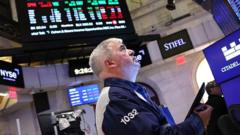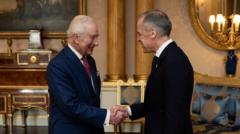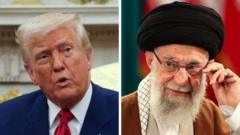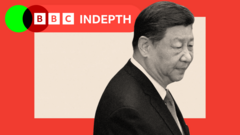In the latest twist of the trade war saga, both nations have publicly denied initiating talks, prompting speculation about who will blink first in their high-stakes negotiations.
**Who Will Yield First in the Ongoing US-China Tariff Standoff?**
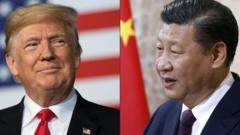
**Who Will Yield First in the Ongoing US-China Tariff Standoff?**
As tensions rise over tariffs between the US and China, both nations seem reluctant to compromise.
In the early hours of Thursday, Chinese state media revealed that the United States has expressed interest in initiating tariff negotiations with Beijing, a noteworthy announcement amidst escalating tariffs reaching as high as 245% on certain Chinese exports. The move raised fears of a looming recession as trade between the two largest economies in the world continues to be choked by these punitive measures. Chinese social media account Yuyuantantian, linked with China Central Television (CCTV), suggested that the US is the more anxious party over the stalled negotiations.
The discourse has become a complex game of brinkmanship between US President Donald Trump and Chinese President Xi Jinping, who are both keen on preserving their national and personal images while indirectly pursuing a de-escalation resolution. Experts liken the situation to a high-speed race, where neither side wants to be the first to back down, fearing a loss of leverage. "The leader who admits to being the first to propose talks risks being perceived as weak," explains Wen-Ti Sung of the Australian Centre on China in the World.
This peculiar dynamic leaves both sides playing a strategic game of "constructive ambiguity," allowing each party to interpret communications in ways that preserve their negotiating positions. Some analysts believe Beijing's vague language is an attempt to find a diplomatic off-ramp to de-escalate tensions without losing face.
Potential third-party mediation could provide the necessary intervention needed to resolve the situation, allowing both US and Chinese leaders to claim victory. Domestic optics play heavily into the negotiations, as both Trump and Xi navigate not just economic realities, but political pressures at home. As the US sees signs of economic contraction while China struggles with falling demand and rising unemployment, both leaders are seeking a way to emerge as winners to their respective constituencies.
However, despite these pressures, neither Trump nor Xi appears ready to yield entirely. "Both sides are caught in a two-level game, striving for concessions while maintaining a façade of strength," explains Sung. Yet, the mere acknowledgment of contact between the two suggests that talks are indeed taking place, leaving observers cautiously optimistic about potential resolutions, albeit highly skeptical regarding the overall trajectory of US-China relations.
In conclusion, the tension-filled atmosphere leaves traders and economists eyeing developments closely, with both nations waiting to see who blinks first in this intricate and consequential trade war.
The discourse has become a complex game of brinkmanship between US President Donald Trump and Chinese President Xi Jinping, who are both keen on preserving their national and personal images while indirectly pursuing a de-escalation resolution. Experts liken the situation to a high-speed race, where neither side wants to be the first to back down, fearing a loss of leverage. "The leader who admits to being the first to propose talks risks being perceived as weak," explains Wen-Ti Sung of the Australian Centre on China in the World.
This peculiar dynamic leaves both sides playing a strategic game of "constructive ambiguity," allowing each party to interpret communications in ways that preserve their negotiating positions. Some analysts believe Beijing's vague language is an attempt to find a diplomatic off-ramp to de-escalate tensions without losing face.
Potential third-party mediation could provide the necessary intervention needed to resolve the situation, allowing both US and Chinese leaders to claim victory. Domestic optics play heavily into the negotiations, as both Trump and Xi navigate not just economic realities, but political pressures at home. As the US sees signs of economic contraction while China struggles with falling demand and rising unemployment, both leaders are seeking a way to emerge as winners to their respective constituencies.
However, despite these pressures, neither Trump nor Xi appears ready to yield entirely. "Both sides are caught in a two-level game, striving for concessions while maintaining a façade of strength," explains Sung. Yet, the mere acknowledgment of contact between the two suggests that talks are indeed taking place, leaving observers cautiously optimistic about potential resolutions, albeit highly skeptical regarding the overall trajectory of US-China relations.
In conclusion, the tension-filled atmosphere leaves traders and economists eyeing developments closely, with both nations waiting to see who blinks first in this intricate and consequential trade war.

